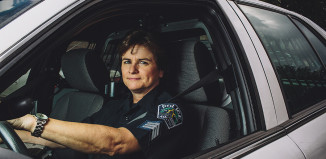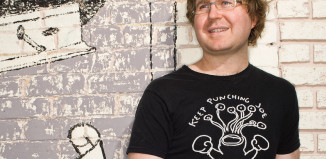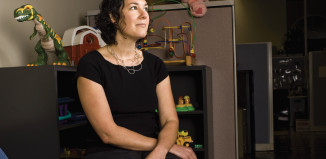Like almost any new parent, it doesn’t take Wil Byrd long to pull out his phone and show off pictures of his son, James. James, age 9, sporting a mohawk–and pulling it off pretty well–appears in some photos with the exasperated look of a child whose parent is taking an awful lot of photos, and in some pictures with the big, sloppy grin of a genuinely happy kid.
That happy grin may be something most families take for granted, but for Wil and his husband Nathan Dance, every happy smile from James represents a big milestone for all of them.
Byrd and Dance adopted James in November 2010 with the help of Caring family network, a nonprofit organization whose mission is to connect children, families and communities. Inherent in that mission is the goal to not just house children, but to heal them. Most of the children who CFN connects with families have been in the custody of Child Protective services and may have been removed from their biological families.
“One of the things children report once they’re removed from their abusive homes, whether they go back to that home or not, is that the foster care system often traumatizes them more than the trauma of their biological home,” said Lisa Martin, director of clinical programming for CFN. “and when you’ve been in the system for a while, that’s not hard to comprehend. Through our training and clinical program, all our foster parents are therapeutic foster home. If you’ve been removed from your home, school, sisters, brothers, your bike, pets–everything you’ve ever known–and are put into another home, with possibly different-colored parents and a different school, you’re going to experience trauma.”
There are about 60 families in CFN’s Austin region, although the organization works with children from all over Texas. This means there’s always a large, albeit shifting, number of children waiting for homes. Martin, who has helped roll out a new trust-based model of care with CFN, said the organization doesn’t try to define what “family” looks like.
“We believe that love comes in all kinds of forms, and that families look all different ways, not necessarily like the American family you see in the media,” Martin said.
Byrd and his husband unfortunately didn’t encounter that kind of openness when they launched their search for an adoptive child. Both knew they wanted kids, and shortly after getting married, they began looking at their options. The two considered everything from foreign adoption–too expensive; to surrogacy–just not right for them. When they initially tried to work with one agency, they were ignored and then told that no foster parents were needed at that time.
Finally, through a friend who at the time worked with CFN, they attended a CFN training and decided to go through the organization to adopt. Thus began a process that was part bureaucratic, part raw emotion, and part patience. The couple submitted a home study and went through the rigorous process of outfitting their house to meet inspection standards. Then came the call that a 7-year old boy needed a home to be placed in, and the reams of paperwork that preceded James arrived.
“When you make the decision to do this, you’re taking what’s usually a very personal and intimate decision between two people and opening up to an entire team doing it with you,” Byrd said. “You’re opening [the experience] up to review, paperwork, bureaucracy–and it’s not your decision anymore. At the end of the day your yes’s and no’s come after other people’s yes’s and no’s.”
But paperwork and bureaucracy haven’t stood in the way of the new family’s bonding and growing love. And on adoption day, Byrd, Dance and James stood in front of a judge’s bench covered with stuffed animals to mark the day’s adoptions and celebrated the fact that they would go home a family.
“I fell in love with James three times,” Byrd said, describing the transition in the getting-to-know process as it moved from paperwork to the literal pitter-patter of feet in their house. “You just realize how helpless this being is, you just can’t not love him.”
There have been challenges: Byrd hypothesizes James must have experienced some kind of trauma in a bathroom, because it took the boy months to be able to shower on his own. James, who has what Byrd describes as profound attention deficit hyperactivity disorder and profound anxiety, at first had trouble even stringing words together to communicate with his adoptive parents. And when he first arrived at his new home, James’ developmental delays were so severe that Byrd and Dance had to sometimes spoon food into his mouth, as a parent of an infant would do.
“It’s very intentional parenting you don’t get to just roll with it,” Martin said of the getting-to-know-you process many adoptive families go through.
If all that sounds like a lot, it is–but day by day the healing process has begun, and the three are now a family. Byrd and Dance have enrolled James in tae Kwon Do and basketball and have family nights each Monday. Their son has friends he hangs out with in school and in the neighborhood. And they have found a supportive community within the CFN family, the Manor school district, and among friends and family.
“Hillary Clinton was right, no matter how trite it’s become, it takes a village to raise a child,” Byrd said.
Now he and Dance are thinking about adopting a second child and plan to work again with CFN.
“If I had a gay friend who said they wanted to have kids, I’d say go to CFN,” Byrd said. “CFN is a family. For me personally, CFN is my extended family.”
Byrd said one of the most important things he can impart to potential adoptive families is to be patient.
“If there’s one thing I’ve learned, it’s nothing even happens when you expect it to happen, even when you get the kid…for a lack of a more mystical term, it’s a blessing and a providence when they come. You can wonder what you did to deserve this, then wonder what you were doing before this.”



































